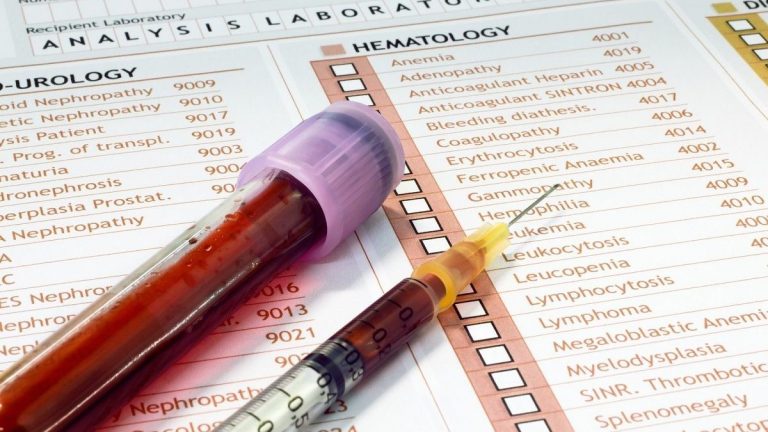
Tumor markers are substances produced by the body when cancer appears.
In many cases, early diagnosis of cancer is crucial to increase the chance of a cure. In this sense, tumor markers can be used to detect the appearance of cancer through a simple blood test.
However, not all cancer patients experience an elevation in tumor markers. Furthermore, elevations of tumor markers can be produced by physiological situations other than cancer.
What are tumor markers?
Tumor markers are proteins that are present in the body in small amounts. However, its levels can increase significantly when some cancerous tumors form.
Where are carcinogenic markers found?
These substances can be found in blood, urine, feces, and other body fluids in cancer patients.
Each tumor marker has a variable profile and is useful for diagnosis, treatment evaluation, and detection of metastases related to specific cancer.
High tumor markers
It is important to bear in mind that not always high tumor markers are due to the presence of a cancerous tumor. Thus, its increase may be determined by other causes.
Thus, the diagnostic utility of tumor markers is relative. It must be contextualized in the reality of each patient and the rest of the tests that are carried out.
Tumor markers in cancer follow-up
Tumor markers are of undoubted utility for the diagnosis of cancer. In addition, in some cases, they are also useful to assess the response to established antitumor treatment. Finally, they can also help detect the reappearance or recurrence of a tumor.
List of tumor markers
As knowledge of cancer and each type of tumor advances, tumor markers grow in number. The most common in medical practice are:
Alpha-fetoprotein or AFP.
Carcinoembryonic antigen or CEA, for its acronym in English.
Prostate-specific antigen or PSA for its acronym in English.
CA 19-9.
CA 15-3.
CA 125.
Human chorionic gonadotropin beta or b-HCG, for its acronym in English.
Lactate dehydrogenase or LDH.
Chromogranin A or Cg A.
Tumor markers in blood
Tumor markers, as mentioned, can be present in various body fluids, although their levels are generally measured in the blood. However, in the case of AFP and CEA, they can be measured in pleural fluid (in case of pleural effusion) or peritoneal fluid (in case of ascites). For CA 15-3 and CA 125, detection can be carried out directly in the tumor.
Normal values of tumor markers
Alpha-fetoprotein (AFP)
It is a protein synthesized by the liver. Its name is because it is normally found in the fetus.
Normal values in adults are below 40 ng / mL.
In the case of pregnant women, the values increase until the 12th week of gestation. From that moment on, the values begin to decrease progressively.
High AFT
High AFT values may indicate the presence of cancer from:
Ovary.
Testicle.
Liver
It can also be related to certain liver diseases, such as hepatitis or cirrhosis.
Carcinoembryonic antigen (CEA)
CEA is a protein that the developing fetus produces normally. However, various types of cancer can cause your blood levels to rise.
The types of cancer that may be related to increased CEA values are the cancer of:
Colon and rectum.
Lung.
Liver.
Pancreas.
Mother.
However, elevated CEA levels can also occur in inflammatory diseases such as hepatitis, pancreatitis, and inflammatory bowel diseases.
CEA high
CEA levels in adults can be affected by several factors. One of them is smoking. Thus, in non-smokers, high values are considered from 5 ng / mL. In smokers, a value of up to 10 ng / mL can be considered normal.
Prostate-specific antigen (PSA)
The prostate specific antigen is a protein that may be present due to the presence of a tumor. However, it can also appear in normal prostate tissues, without the need for the presence of cancer.
Finally, the PSA can also be elevated in benign prostatic diseases.
High PSA
A high PSA value is considered from 4 ng / mL. Above this level, it is necessary to consider the specific circumstances of each patient. Thus, for example, patients older than 70 years have normal values of up to 6.5 mg / ml
Values greater than 10 mg / ml make it necessary to examine the prostate for a tumor.
On the other hand, the PSA can suffer increases due to circumstances other than cancer:
Benign prostatic hyperplasia. This increase in the size of the prostate is a process that occurs regularly from the age of 50. Each gram of prostate enlargement can lead to an increase in PSA of up to 0.2 ng / ml.
Prostitutes. It is an inflammation of the prostate, mainly due to an infection.
Urinary retention.
Trauma to the perineum area (between the anus and the genitals).
After a prostate basis.






